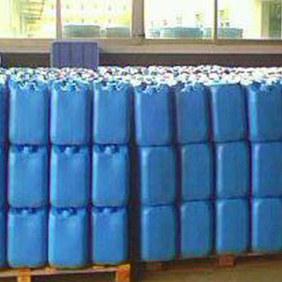


Product Name: Triallyl Isocyanurate
English name: 1,3,5-Tri-2-propenyl-1,3,5-triazine-2,4,6(1H,3H,5H)-trione, TAIC for short
Scientific name: 1,3,5-triallyl-s-triazine-2,4,6-trione
Also known as: triallyl isocyanurate
Molecular formula: C12H15N3O3 Molecular weight: 249.27 CAS NO.: 1025-15-6
One: Quality indicators:
Product Name: Triallyl Isocyanurate (TAIC, Crosslinking Agent, Vulcanizing Agent)
project | index | |||
Industrial products | premium product | boutique | powder | |
Exterior | light yellow liquid or crystal | light yellow liquid or crystal | Colorless transparent liquid or crystal | White powder |
content | ≥95% | ≥98% | ≥99% | ≥70% |
acid value | ≤0.5mgKOH/g | ≤0.3mgKOH/g | ≤0.2mgKOH/g | —— |
Two: Physical properties:
Molecular weight: 249.27
Appearance: Colorless liquid or crystal at room temperature (25°C)
Properties: Colorless or light yellow liquid or hexagonal flaky crystal at room temperature.
Specific gravity: 1.155 (30°C)
Specific heat: 0.6 (40°C)
Melting point: 23°C—26°C (pure product) 17°C—21°C (industrial grade)
Flash point: 355°C
Viscosity: 86±3 centipoise (30°C)
Boiling point: 144°C/3mmHg; 297°C/N2, 760mmHg
Solubility: Soluble in aromatic hydrocarbons, halogenated hydrocarbons, cycloalkanes, acetone, various alcohols, etc., slightly soluble in alkanes, insoluble in water.
Three: chemical properties:
It is very stable at room temperature and can be stored at room temperature for a long time. The functional groups of TAIC are three allyl groups, which have the general properties of aliphatic olefins, such as various addition reactions, homopolymerization and copolymerization reactions, Prins reactions, etc. Initiated by peroxide, TAIC is more likely to undergo polymerization reaction than other allyl groups. It will undergo self-polymerization reaction when heated above 140°C in air, and become a transparent and hard homopolymer.
Four: Toxicity:
Mice (oral) LD59=666mg/kg (nearly non-toxic).
Homopolymers and vinyl monomers of TAIC, as well as thermoplastics crosslinked by TAIC, are drug-free.
Five: Uses:
1. Cross-linking and modification of various thermoplastics (polyethylene, polyvinyl chloride, chlorinated polyethylene, EVA, polystyrene, etc.). Thermal crosslinking one
The general addition amount is 1-3%, plus 0.2-1% of dicumyl peroxide (DCP); the addition amount of irradiation crosslinking is 0.5-2%, and DCP can be omitted. After cross-linking, the heat resistance, flame retardancy, solvent resistance, mechanical strength and electrical properties of the product can be significantly improved. Compared with the cross-linking of peroxide system alone, it can significantly improve the product quality, and has no peculiar smell. Typically used in polyethylene, polyethylene/chlorinated polyethylene, polyethylene/EVA cross-linked cables and polyethylene high and low foaming products.
2. Assisting vulcanization of ethylene-propylene rubber, various fluororubbers, CPE and other special rubbers (used together with DCP, the general dosage is 0.5-4%), which can significantly shorten the vulcanization time, improve strength, wear resistance, solvent resistance and resistance corrosive.
3. Crosslinking of acrylic and styrene ion exchange resins. Compared with the divinylbenzene crosslinking agent, it uses less amount, has high quality, and can prepare ion exchange resins with excellent properties such as antifouling, high strength, large pore size, heat resistance, acid and alkali resistance, and oxidation resistance. This is a new type of ion exchange resin newly developed at home and abroad with excellent prospects.
4. Modification of polyacrylate, polyalkylacrylate, etc. Can significantly improve heat resistance, optical properties and process performance. Typically used for heat-resistant modification of ordinary plexiglass.
5. Modification of epoxy resin and DAP (diallyl phthalate) resin. Improves heat resistance, adhesion, mechanical strength and dimensional stability. Typically used for modification of epoxy potting and encapsulating compounds.
6. Crosslinking and modification of unsaturated polyester and thermoplastic polyester. It can significantly improve heat resistance, chemical corrosion resistance, dimensional stability, weather resistance and mechanical properties. It is typically used to improve the heat resistance of hot-pressed unsaturated polyester FRP products, and the modified products can be used at temperatures above 180°C.
7. Polytriallyl isocyanurate, the homopolymer of TAIC itself, is a transparent, hard, heat-resistant and excellent electrical insulation resin, and can also be used to bond glass and ceramics. Typically used in the manufacture of multilayer safety glass.
8. Internal plasticization of polystyrene, copolymerization modification of styrene and TAIC, etc., can produce transparent and shatter-resistant products.
9. Protective agent for metal heat resistance, radiation resistance and weather resistance. TAIC prepolymer is baked and plated on the metal surface, and its baked coating has excellent heat resistance, radiation resistance, weather resistance and electrical insulation. Typically used for insulating materials such as printed circuit boards in the manufacture of microelectronics.
10. Used as an intermediate for photocurable coatings, photoresists, flame retardants, and flame retardant crosslinking agents. Typically used in the synthesis of high-efficiency flame retardant TBC and flame retardant cross-linking agent DABC.
Six: Packaging, storage and transportation:
There are two types of packaging for liquid TAIC, 25KG and 200KG, and they are packed in reinforced plastic drums and galvanized white iron drums. Among them, 200KG is limited to packaging in white iron galvanized barrels.
Powdered TAIC packaging is divided into: paper drum packaging, net weight 25kg per drum, woven bag packaging, net weight 25kg per bag, storage and transportation as non-toxic and non-dangerous goods, avoid high temperature exposure.
TAIC is a non-dangerous product with low toxicity, non-flammability, non-explosiveness, and no harm to the environment. It is stored and transported as a non-dangerous product. TAIC should be stored in a cool, dark and airtight condition.